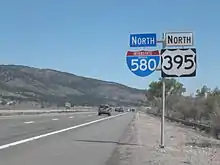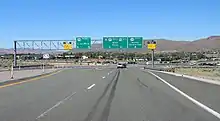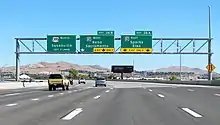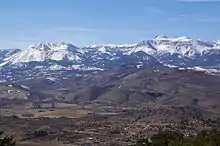Interstate 580 (Nevada)
Interstate 580 (I-580) is a 35.019-mile (56.358 km) auxiliary Interstate Highway in Western Nevada. It runs concurrently with US Route 395 (US 395) from an intersection with US 50 near the southern boundary of Carson City to the Reno Spaghetti Bowl interchange with I-80 in Reno. The freeway provides a high-speed direct route between Lake Tahoe and Carson City to Reno and I-80.
Interstate 580 | ||||
|---|---|---|---|---|
I-580 highlighted in red | ||||
| Route information | ||||
| Auxiliary route of I-80 | ||||
| Maintained by NDOT | ||||
| Length | 35.019 mi[1] (56.358 km) | |||
| Existed | October 27, 1978–present | |||
| History | Number approved on October 27, 1978; constructed in phases 1964–2017; signed in 2012 | |||
| NHS | Entire route | |||
| Major junctions | ||||
| South end | ||||
| North end | ||||
| Location | ||||
| Country | United States | |||
| State | Nevada | |||
| Counties | City of Carson City, Washoe | |||
| Highway system | ||||
| ||||
| ||||
Construction on a freeway between Carson City and Reno was planned since 1956, but construction did not occur until 1964. The freeway opened in sections, with the final section opening on August 2, 2017. The I-580 designation was approved on October 27, 1978, but the freeway was not signed as such until the portion between Reno and Carson City was completed following the opening of the Galena Creek Bridge in late August 2012.
Route description

I-580 runs from an intersection with US 50 in Carson City to an interchange with I-80 near downtown Reno. The only portion remaining to be constructed is the interchange at the freeway's southern terminus. Within Reno, the freeway is designated as the Martin Luther King Jr. Freeway. Within Carson City, the freeway is designated the Carson City Deputy Sheriff Carl Howell Memorial Freeway, in honor of a sheriff's officer who was shot to death while attempting to rescue a victim of domestic violence from her house.[2][3]
The freeway begins at the junction (future single-point urban interchange) of US 395 with the Lake Tahoe leg of US 50 and follows the eastern edge of Eagle Valley, where most of the population of Carson City resides. The highway loosely follows the former alignments of Edmonds Drive and Lompa Lane along the eastern half of the city, which were relocated or truncated to make room for the freeway.
After rejoining the original alignment of US 395 at the Carson Tahoe Regional Medical Center, the highway crests Lakeview Hill to enter the Washoe Valley. The portion of I-580/US 395 and US 395 Alternate (US 395 Alt) through Washoe Valley are prone to high crosswinds, and, as such, the highways are frequently closed to high-profile vehicles. During prohibited times, trucks are rerouted to State Route 428 (SR 428/Eastlake Boulevard) and US 395 Alt, which is the old route of US 395. The high-wind area ends near the Bowers Mansion interchange near the northern end of the Washoe Valley.
Unlike the old US 395 which ran along the valley floor of Pleasant Valley, I-580 is routed in the mountains overlooking the valley and crosses the Galena Creek Bridge, the largest cathedral arch bridge in the world.[4] Along the descent from these mountains into the Truckee Meadows and Reno, the highway cuts through the center of one of the largest geothermal powerplants in the US, Ormat Technologies's Steamboat Hills Complex power station.[5] The freeway also passes between the clusters of Hot Springs in Steamboat Hills that provide steam for the plant.


At the extreme southern edge of Reno, the highway has a junction with the Mount Rose Highway (SR 431) and Geiger Grade (SR 341), which connect the freeway with North Lake Tahoe and Virginia City, respectively. Upon entering Reno, the freeway proceeds in a generally northern direction, crossing Virginia Street (SR 430), the old routing of US 395, several times. Along the way, the freeway passes to the side of The Summit mall, Meadowood Mall, and Reno–Tahoe International Airport. The elevated freeway also passes over a bus garage used by RTC Washoe, the local bus agency.[6] The I-580 designation ends at the Reno Spaghetti Bowl where the highway crosses I-80; however, the freeway continues on only as US 395, heading toward the north valley neighborhoods of Sun Valley, Lemmon Valley, Stead, Cold Springs Valley, and Bordertown (parts of which are in the city of Reno[7]) before eventually crossing the California state line.
History

Development of the I-580/US 395 freeway has been in planning since 1956, but significant construction did not occur until 1964.[8] The freeway would be opened gradually over time and would initially be constructed in two main separate sections before 2012.
The first segment of freeway constructed along I-580 was the Washoe Valley segment, which was constructed between 1964 and 1970 between present-day Bowers Mansion Road/Carson–Reno Highway (exit 50, now exit 16) near Washoe City, south through Washoe Valley to just north of North Carson Street (exit 43, now exit 8) in Carson City.
The Reno section was constructed between 1973 and 1996. In 1973, the section running between US 395 Business (US 395 Bus; exit 72) to East Second Street/Glendale Avenue (exit 67, now exit 35) in Reno opened to traffic. This section was extended south to Mill Street (exit 66, now exit 34) in 1978, Plumb Lane/Villanova Drive (exit 65, now exit 33) in 1979, South Virginia Street/Kietzke Lane (exit 63, now exit 31) in 1981, Neil Road/Meadowood Mall Way (exit 62, now exit 30) in 1986, South Virginia Street (exit 61, now exit 29) in 1989, and Mount Rose Highway (exit 56, now exit 24) in 1996. The Carson City section was constructed in the 2000s with the construction of the Carson City Bypass project. The first phase completed the freeway from North Carson Street (exit 43, now exit 8) south to East William Street (exit 39, now exit 5) in 2006. The freeway was extended south to Fairview Drive (exit 38, now exit 3) in 2009. On August 2, 2017, the final section of the freeway between Fairview Drive (exit 38, now exit 3) and South Carson Street in Carson City opened to traffic.[9]
In 2012, the section between Mount Rose Highway (exit 56, now exit 24) and Bowers Mansion Road/Carson–Reno Highway (exit 50, now exit 16) south of Reno opened following the opening of the Galena Creek Bridge to traffic in late August 2012, connecting the two main segments together. After the completion of this section, the freeway south of I-80 (US 395 southbound exit 68 and I-580 northbound exit 36) was signed as I-580, officially connecting Carson City to the Interstate Highway System. This left four other state capitals still not served by the Interstate Highway System: Dover, Delaware; Juneau, Alaska; Pierre, South Dakota; and Jefferson City, Missouri.[10]
The I-580 designation was first approved by the American Association of State Highway and Transportation Officials (AASHTO) on October 27, 1978; at the time, this route extended from I-80 to US 395 (South Virginia Street, at exit 63, now exit 31).[11][12] AASHTO approved the remainder of planned I-580, to the southern terminus at US 50, US 395 and US 395 Bus south of Carson City, at its December 7, 1984, meeting.[13] Despite the route number being approved and being shown on some maps in the 1980s, I-580 was not signed along the Interstate until the freeway gap between Mount Rose Highway and Bowers Mansion Road was completed in 2012.
In October 2019, the Nevada Department of Transportation (NDOT) began replacing US 395 exit numbers with I-580 exit numbers per federal requirements on the Manual on Uniform Traffic Control Devices.[14] It was completed in spring 2020.[15]
Future
The only project yet to be completed as of 2022 is the South Carson Street single-point urban interchange (SPUI).[16]
Exit list
Old exits on I-580 were numbered according to US 395 mileposts.
| County | Location | mi | km | Old exit | New exit[17] | Destinations | Notes |
|---|---|---|---|---|---|---|---|
| City of Carson City 0.00–9.43 | 0.00 | 0.00 | — | — | Temporary at-grade intersection; planned upgrade to SPUI interchange; southern end of US 50/US 395 concurrency; S. Carson Street was former SR 529 north/US 50 east/US 395 north[18] | ||
| 2.84 | 4.57 | 38 | 3 | Fairview Drive | |||
| 4.57 | 7.35 | 39 | 5 | Northern end of US 50 concurrency; E. William Street was former SR 530 west/US 50 west/US 395 south | |||
| 6.73 | 10.83 | 41 | 6 | College Parkway | Former SR 531 | ||
| 8.03 | 12.92 | 42 | 7 | Arrowhead Drive | Northbound exit and southbound entrance | ||
| 8.46 | 13.62 | 43 | 8 | Southbound exit and northbound entrance; former US 395 south | |||
| Washoe 9.43–35.187 | Washoe Valley | 9.37 | 15.08 | 44 | 10 | Eastlake Boulevard (to US 395 Alt.) | Former SR 428; serves Washoe Lake State Park |
| 11.20 | 18.02 | 46 | 12 | Bellevue Road | |||
| Washoe City | 15.46 | 24.88 | 50 | 16 | Old US 395 (US 395 Alt., Bowers Mansion Road, Carson–Reno Highway) – Washoe City | Former SR 429 south/SR 430 north/US 395; serves Bowers Mansion | |
| | 19.50 | 31.38 | Galena Creek Bridge | ||||
| Reno | 23.46 | 37.76 | 56 | 24 | |||
| 24.94 | 40.14 | 57B | 25B | S. Virginia Street south (US 395 Alt. south) – Virginia City, Washoe City | Southbound exit and northbound entrance; former SR 430 south/US 395 south | ||
| 25.40 | 40.88 | 57A | 25A | S. Virginia Street north (US 395 Alt. north / US 395 Bus. north) | Southbound exit and northbound entrance; former SR 430 north/US 395 north | ||
| 25.58 | 41.17 | 59 | 26 | Damonte Ranch Parkway | |||
| 26.89 | 43.28 | 60 | 28 | South Meadows Parkway (SR 426 west) | |||
| 27.98 | 45.03 | 61 | 29 | S. Virginia Street (US 395 Alt. / US 395 Bus.) | Former SR 430/US 395 | ||
| 30.19 | 48.59 | 62 | 30 | Neil Road, Meadowood Mall Way | Neil Road was former SR 667 | ||
| 30.97 | 49.84 | 63 | 31 | S. Virginia Street (US 395 Bus.), Kietzke Lane | Southbound exit and northbound entrance; S. Virginia Street was former SR 430/US 395; Kietzke Lane was former SR 667 | ||
| 32.03 | 51.55 | 64 | 32 | Moana Lane | Diverging diamond interchange; serves Reno-Sparks Convention Center | ||
| 32.95 | 53.03 | 65 | 33 | Signed as exits 33A (Villanova Drive, Plumb Lane) and 33B (airport) southbound | |||
| 33.93 | 54.61 | 66 | 34 | Mill Street | |||
| 34.46 | 55.46 | 67 | 35 | E. Second Street, Glendale Avenue (SR 648) | |||
| 35.19 | 56.63 | 68 | 36 | Northern terminus; northern end of US 395 concurrency; signed as exits 36A (east) and 36B (west) northbound; I-80 exit 15; highway continues as US 395 north | |||
1.000 mi = 1.609 km; 1.000 km = 0.621 mi
| |||||||
See also
References
- "Table 2: Auxiliary Routes of the Dwight D. Eisenhower National System Of Interstate and Defense Highways". FHWA Route Log and Finder List. Federal Highway Administration. December 31, 2021. Retrieved July 11, 2022.
- Munson, Jeff (December 8, 2015). "Stretch of Carson City Freeway Officially Named in Honor of Deputy Carl Howell". Carson Now. Retrieved December 8, 2015.
- Munson, Jeff (August 16, 2015). "Carson City Deputy Killed in the Line of Duty Identified". Carson Now. Retrieved December 8, 2015.
- Robison, Mark. "Fact Checker: Is Galena Creek the world's longest cathedral arch bridge?". Reno Gazette Journal. Retrieved August 3, 2021.
The Nevada DOT claim is accurate but 'cathedral' arch bridges are very rare and so it is sort of a record that is trying to be specific so they can claim the top spot. It is the second longest concrete arch in America after the Hoover Dam bypass bridge, which is an impressive achievement itself. However among all concrete arches in the world, it does not even rank among the top 20 so I can understand NDOT wanting to bring its status up in the ranks.
- "US Energy Project". Ormat Technologies. Retrieved February 28, 2023.
- "RTC Villanova Maintenance Facility Renovation and Expansion Project". City of Reno. p. 15. Archived from the original on October 5, 2018. Retrieved October 4, 2018.
- "Ward Map | City of Reno". www.reno.gov. Retrieved December 20, 2021.
- Nevada Department of Transportation. "History & Overview". I-580 Extension Project website. Nevada Department of Transportation. Archived from the original on May 27, 2008. Retrieved September 11, 2008.
- Deach, Ben (August 2, 2017). "Freeway Extension to Save Drivers Time in Carson City". Reno, NV: KOLO-TV. Retrieved August 2, 2017.
- Rocha, Guy (February 28, 2006). "Carson City's freeway: a long time coming". Nevada Appeal. Archived from the original on June 25, 2018. Retrieved June 24, 2018.
- Special Committee on U.S. Route Numbering (October 28, 1978). "Route Numbering Committee Agenda Showing Action Taken by the Executive Committee" (Report). Washington, DC: American Association of State Highway and Transportation Officials. Retrieved November 7, 2014 – via Wikisource.
- "A drive on 395 is a drive on 580". Reno Gazette-Journal. December 13, 1978. p. 27. Retrieved June 24, 2018 – via Newspapers.com.

- Special Committee on U.S. Route Numbering (December 7, 1984). "Route Numbering Committee Agenda" (PDF) (Report). Washington, DC: American Association of State Highway and Transportation Officials. Retrieved November 7, 2014 – via Wikimedia Commons.
- Team, News 4-Fox 11 Digital (October 5, 2019). "I-580 exit numbers to change in Carson City". KRNV. Retrieved May 20, 2023.
- Hoover, R. (March 23, 2020). "Exit numbers changing on I-580 from Carson City to Reno". Nevada Appeal. Retrieved May 20, 2023.
- "Capital Transportation Improvement Projects". Nevada Department of Transportation. Retrieved February 14, 2021.
- Nevada Department of Transportation. "Exit Numbers on Interstate 580". Nevada Department of Transportation. Retrieved May 13, 2019.
- "Capital Transportation Improvement Projects". Nevada Department of Transportation. Retrieved February 14, 2021.
.svg.png.webp)